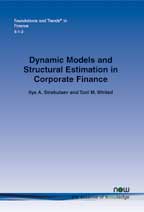Dynamic Models and Structural Estimation in Corporate Finance
By Ilya A. Strebulaev, Graduate School of Business, Stanford University and National Bureau of Economic Research, USA, istrebulaev@stanford.edu | Toni M. Whited, University of Rochester, USA, toni.whited@simon.rochester.edu
Abstract
We review the last two decades of research in dynamic corporate finance, focusing on capital structure and the financing of investment. We first cover continuous time contingent claims models, starting with real options models, and working through static and dynamic capital structure models. We then move on to corporate financing models based on discrete-time dynamic investment problems. We cover the basic model with no financing, as well as more elaborate models that include features such as costly external finance, cash holding, and both safe and risky debt. For all the models, we offer a minimalist, simplified presentation with a great deal of intuition. Throughout, we show how these models can answer questions concerning the effects of financial constraints on investment, the level of corporate leverage, the speed of adjustment of leverage to its target, and market timing, among others. Finally, we review and explain structural estimation of corporate finance models.
Dynamic Models and Structural Estimation in Corporate Finance
Dynamic Models and Structural Estimation in Corporate Finance has three goals: (1) To explain the models and techniques used in this literature as simply as possible, with the intent of making the literature more accessible. (2) To introduce the reader to the main strands of this literature. This monograph can therefore be viewed in part as a literature review and in part as a tutorial. (3) To explain how dynamic models can be taken to the data and be estimated with the intent to provide a practical, hands-on guide to three specific methodologies that have been used in the literature: generalized method of moments, simulated method of moments, and maximum simulated likelihood. Dynamic Models and Structural Estimation in Corporate Finance provides a concise guide to the extant structural estimation literature in corporate finance. Following an introduction, Section 2 provides an overview of dynamic corporate finance models based on techniques developed in the continuous time contingent claims literature. Section 3 covers a separate strand of the literature that stems discrete time investment models. Section 4 reviews the relatively small number of different econometric techniques that have been used to estimate these models, as well as the studies that have used them. The authors close with a brief overview of directions for future research.
